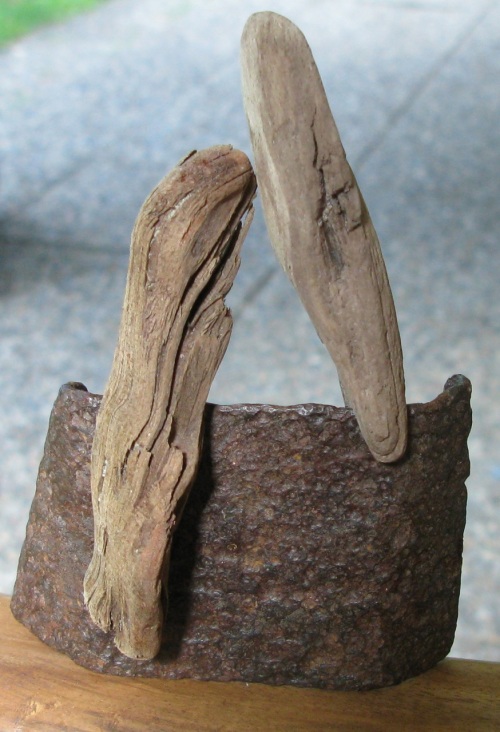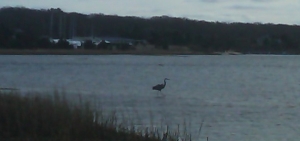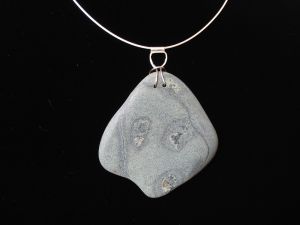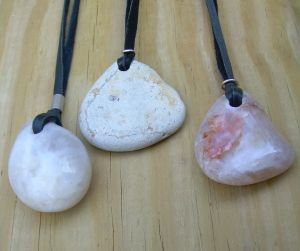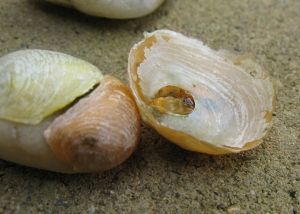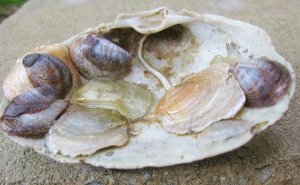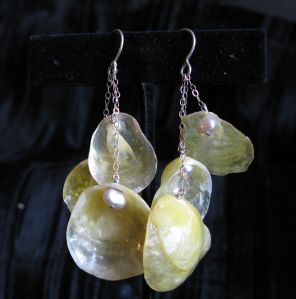Just after New Year (Jan 2014) we went for a walk in Shadmoor Park and ended up on Ditch Plains Beach. That is where I found two vertebrae still stuck together by ligaments. They were larger than human vertebrae, measuring 3-4 inches in the largest diameter. A quick phone call to my biologist friend, Marguerite W, confirmed that these were mammalian bones and not from a large fish, like a shark. Fish vertebral bodies (called the centrum) would be biconcave, as shown here. These were not. Then, I had a phone call with a friend, Annie Sessler. She is a well known artist out here who makes beautiful fish prints! Her husband Jim, is a Montauk fisherman. ‘Some kind of whale’ or marine mammal was their opinion. Now I was really intrigued!![photo[6]](https://maidstonejewelry.files.wordpress.com/2014/03/photo6.jpg?w=300&h=225)
![photo[5]](https://maidstonejewelry.files.wordpress.com/2014/03/photo5.jpg?w=225&h=300) Then I got this rare book from the Cornell Vet School library called “Whales of the World” by Spencer Wilkie Tinker (1988). It describes in detail all 77 species of living whales on this planet and also a bunch of extinct species based on fossil records.
Then I got this rare book from the Cornell Vet School library called “Whales of the World” by Spencer Wilkie Tinker (1988). It describes in detail all 77 species of living whales on this planet and also a bunch of extinct species based on fossil records.
It was a stroke of luck that we could identify the vertebrae (which were stuck together) as C7, T1. That’s the last cervical and the first thoracic vertebrae. The thoracic vertebrae have an articular joint surface for a rib on either side. All mammals have 7 cervical (neck) vertebrae. Giraffe’s have very long ones. Some animals have very short ones. And sometimes the cervical vertebrae are fused together! However, C7 in our case was not fused to either of its neighboring vertebrae, T1 or C6. The “common dolphin” has fused C1-7, according to “Whales of the World”. Therefore we did not think that these were vertebrae from the common dolphin. In the same book, there is a photograph on page 39 of a side view of a cervical spine of the common dolphin. To my astonishment T1 looked just like the T1 vertebra that we found! So, we were thinking of a close relative of the common dolphin.
The size of the vertebrae we found suggested an animal slightly larger than a human (approx 75-200 kg). Using this as a guide, I then focused on 8 species listed in the whale book, that live in the North Western Atlantic, at our latitude 40 N . I googled which of these species had recently been spotted in the waters around Long Island. The list was now really short:
- bottlenose dolphin
- common dolphin (unlikely because of the fused C spine)
In particular, there were lots of sightings and on-line reports about bottlenose dolphins around Long Island.
Apparently there has been an epidemic due to a type of measles virus and it has killed hundreds of bottlenose dolphins in our waters (in the Long Island sound and around Montauk). This species has apparently been migrating northwards as witnessed by the larger numbers spotted since about 2007.
Here are some links which I found interesting:
- Mass strandings of dolphins in East Hampton in 2007
- Bottlenose dolphins in Long Island Sound by Arthur Kopelman PhD – Pesident of the Coastal Research and Education Society of Long Island (CRESLI)
- Deadly Dolphin Disease Spreads South, Nov 2013
- The Waters Around Us: Whales and Other Marine Animals, this is about whale watching off of Long Island
- Dolphins: A Fleeting Glimpse? About increased numbers of bottlenose dolphins in Long Island Sound.
Having been introduced to this species by their bones, I noted that these are in fact very interesting animals! Bottlenose dolphins can recognize themselves in a mirror! They can use sponges as tools and transmit cultural knowledge across generations. Their considerable intelligence has driven interaction with humans. I am now an official dolphin fan!




